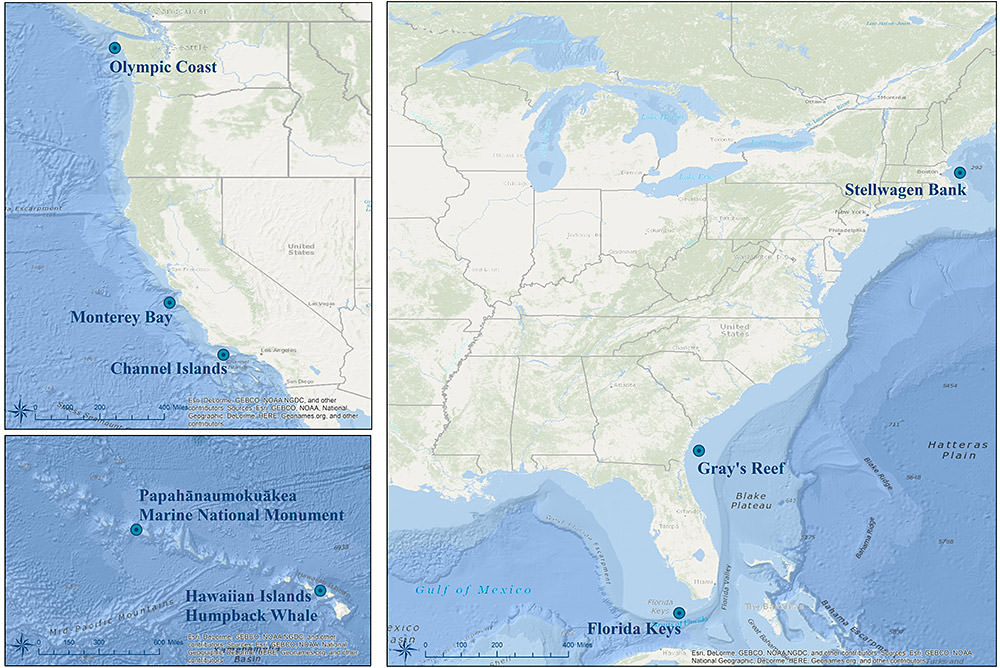Killer Whale Sound Production at SanctSoundSite OC01_03
This record represents killer whale sound production. Killer whale calls were detected
by analysts and logged using Triton's Logger Remora. Calls were grouped into encounters,
with encounters more than 30 min apart being logged as separate encounters. The following
settings were used for manual scanning of long-term spectral averages: bandwidth 0-5000
Hz; 1 hour duration; and for zoomed-in scanning of spectrograms: plot length 30 s,
FFT length 1000, 90% overlap. Killer whale encounters were further classified into
ecotypes based on the presence of ecotype-specific call types in the encounter. Call
types were identified in the spectrogram window, and all calls in an encounter were
examined before an encounter was attributed to a particular ecotype. Resident ecotype
call types were identified from the reference catalogue of Ford 1987, transient ecotype
call types were identified from a reference catalogue based on recordings published
by Deecke 2003, and offshore ecotype call types were identified from a digital catalogue
(J Ford, unpubl. data) collected during field encounters with photo- or genetically
identified offshore killer whales.These data were recorded at SanctSound Site OC01_03
between November 02, 2019 and April 10, 2020.
- Cite as: NOAA Office of National Marine Sanctuaries and U.S Navy. 2021. Killer Whale Sound Production at SanctSoundSite OC01_03, SanctSound Data Products. NOAA National Centers for Environmental Information. https://doi.org/10.25921/h4ac-dr23. [access date].
- 10.25921/h4ac-dr23
- NCEI Metadata ID: gov.noaa.ncei.pad:NOAA-Navy-SanctSound_OC01_03_killerwhale
gov.noaa.ncei.pad:NOAA-Navy-SanctSound_OC01_03_killerwhale
| Search Data |
|
| Download Data |
|
| Distribution Formats |
|
| Ordering Instructions | Contact NCEI for other distribution options and instructions. |
| Distributor | NOAA National Centers for Environmental Information ncei.info@noaa.gov |
| Dataset Point of Contact | NOAA National Centers for Environmental Information ncei.info@noaa.gov |
| Dataset Point of Contact | Carrie Wall NCEI Passive Acoustic Archive Lead NOAA National Centers for Environmental Information pad.info@noaa.gov |
| Coverage Description | Site OC01_03 |
| Time Period | 2019-11-02T19:00:00Z to 2020-04-10T20:00:00Z |
| Spatial Bounding Box Coordinates |
West:-124.62066999999999
East:-124.62066999999999
South:48.3938
North:48.3938
|
| Spatial Coverage Map | |
| General Documentation | |
| Associated Resources |
|
| Publication Dates |
|
| Edition | Final SanctSound Data Product |
| Dataset Progress Status | Complete - production of the data has been completed |
| Data Update Frequency | As needed |
| Purpose | These data are available to the public for a wide variety of uses including scientific research and analysis. |
| Dataset Citation |
|
| Cited Authors |
|
| Principal Investigators |
|
| Publishers |
|
| Acknowledgments |
|
| Theme keywords | Global Change Master Directory (GCMD) Science Keywords
|
| Data Center keywords | Global Change Master Directory (GCMD) Data Center Keywords
|
| Platform keywords | Global Change Master Directory (GCMD) Platform Keywords
|
| Instrument keywords | Global Change Master Directory (GCMD) Instrument Keywords
|
| Place keywords | Global Change Master Directory (GCMD) Location Keywords
|
| Project keywords | Global Change Master Directory (GCMD) Project Keywords
|
| Use Constraints |
|
| Access Constraints |
|
| Other Constraints | Cite as: NOAA Office of National Marine Sanctuaries and U.S Navy. 2021. Killer Whale Sound Production at SanctSoundSite OC01_03, SanctSound Data Products. NOAA National Centers for Environmental Information. https://doi.org/10.25921/h4ac-dr23. [access date]. |
| Fees |
|
| Processing Steps |
|
| Instrument |
|
| Platform |
|
Last Modified: 2023-06-15
For questions about the information on this page, please email:ncei.info@noaa.gov
